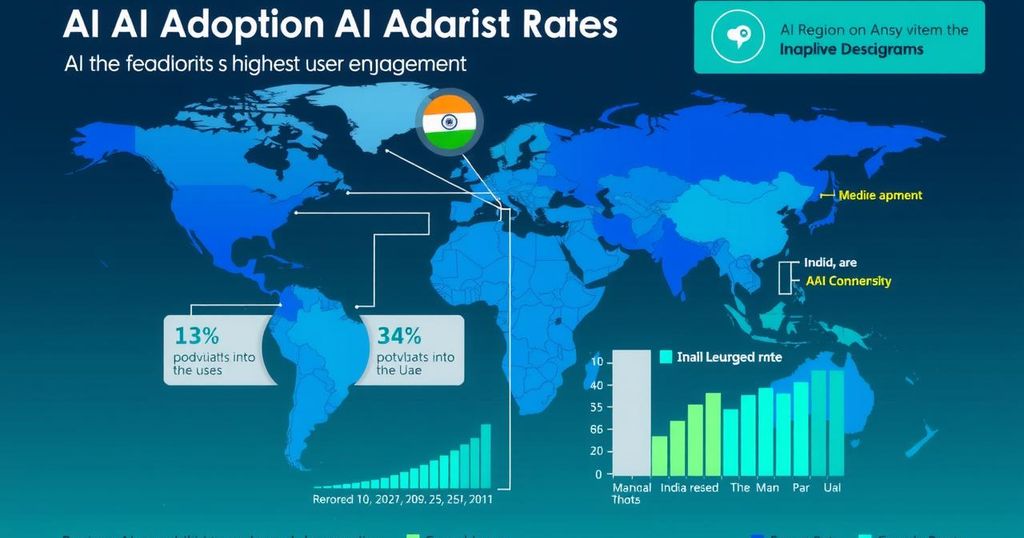How Many Companies Use AI? New Data Reveals Adoption Rates
A recent surge in AI adoption in businesses, with 40% currently using AI, and 82% exploring its use, highlights a significant shift in corporate practices. India leads in AI implementation at 59%, while the U.S. trails with 33%. The AI market is projected to reach $1.85 trillion by 2030, driven by demand for efficiency and cost-cutting measures.
Artificial intelligence (AI) is swiftly becoming a cornerstone of modern business practices. While companies have dabbled in AI for cost-saving measures for quite some time, the advent of generative AI technologies—especially large language models such as ChatGPT, Claude, and Midjourney—has made AI a crucial part of many corporate strategies. In this overview, we’ll dig deeper into the current landscape of AI adoption, trends, and what the future holds for businesses worldwide.
First off, let’s dive into some eye-catching statistics. A noteworthy 40% of global companies presently utilize AI. Meanwhile, about 82% of organizations are in either the process of using AI or considering it—an amazing number when you consider that only 20% of businesses had onboarded AI back in 2017. Dominating the charts, India leads with a 59% adoption rate, indicating a robust embrace of AI applications. The global AI market is projected to balloon to $1.85 trillion by 2030. Evidence shows that bigger enterprises are about twice as likely to use AI compared to their smaller counterparts.
Speaking of usage rates, in 2024, 40% of companies are officially using AI, while an additional 42% are in exploratory stages, meaning a whopping 82% are involved with AI in some capacity. This translates to about 266 million companies worldwide exploring or leveraging AI in their operations. This rapid uptake isn’t just a blip; AI adoption soared from 20% in 2017 to a jaw-dropping 72% projected for 2024.
But what are companies actually doing with AI? According to findings, customer service reigns supreme as the most common use for AI, with a robust 56% of businesses incorporating it into their customer service framework. Other popular uses include cybersecurity and fraud prevention at 51%, and digital assistants at 47%, among others. AI is reshaping roles like customer relationship management and inventory management, holding relentless potential to boost efficiency.
Regionally speaking, the AI race sees India in front, but the UAE and Singapore follow closely behind with 58% and 53% adoption, respectively. Surprisingly, the United States lags here, only reaching a 33% AI adoption rate. Let’s look at some countries and their AI deployment rates: China and India, respectively recording 50% and 59%, paint a picture of significant AI utilization. In contrast, countries like France and Spain show lower figures, with only 26% and 28% adoption rates.
The market dynamics for AI are quite promising. Projections suggest that the industry will achieve a staggering 37.3% compound annual growth rate (CAGR) from 2024 to 2030. Larger companies dominate this landscape, where adoption is notably higher. For instance, over 50% of US firms with more than 5,000 employees are already using AI tech.
Looking to the future, AI’s role as a business ally will likely keep growing. Data from 2024 indicates that each employee can save approximately 2.5 hours daily due to AI, and 28% of business leaders are already leveraging AI to cut costs. A hot job market awaits those skilled in AI processes; many executives report hiring staff to facilitate AI integration.
In summary, the road for AI in business is paved with potential. As more companies seek efficiency and lower costs, investment and reliance on AI tools are set to rise. For those keen on the AI trajectory, further insights into market trends and growth await in related articles like AI Market Size and Top AI Trends.
The rapidly expanding AI market signals a growing acceptance and implementation of AI technologies across businesses worldwide. The consistent rise in adoption rates, fueled by advancements in tools and processes, suggests that AI will play an even more vital role in decision-making and operations going forward. As companies strive for efficiency and cost-effectiveness, the AI landscape is set for remarkable growth, promising a bright future for both sectors and job markets alike.
Original Source: explodingtopics.com




